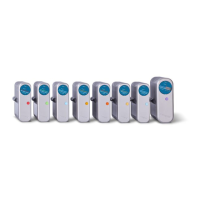ENGINEERING MANUAL OF AUTOMATIC CONTROL
CHILLER, BOILER, AND DISTRIBUTION SYSTEM CONTROL APPLICATIONS
302
It is desirable for the BMCS to have access to the chiller-
controller database, but due to the cost and complexity of a custom
interface to convert the data to a format acceptable to the BMCS,
it is seldom done. Adoption of open communication standard
protocols as the ASHRAE BACnet and the Echelon LonMark™
will replace the expensive interfaces with direct interfaces.
CHILLED WATER SYSTEMS
CENTRAL COOLING PLANTS
The central cooling system generates chilled water for
distribution to a building or group of buildings. It consists of
one or more chillers. Multiple chillers may all be the same or
different capacities and/or different types. The energy may be
provided by electricity or a fuel-combustion source. Central
chiller system optimization is an important control function to
minimize energy use, especially in multiple chiller plants. The
control program must be dynamic and constantly check current
conditions and adjust chiller system operations accordingly. A
control program must select the most efficient loading and
chiller combinations then, sequence pumps and control cooling
towers to match the current load condition. Built-in safeguards
prevent short cycling and exceeding demand limits. Strategies
for total chiller system optimization include:
1. Supplying chilled water at a temperature that minimizes
chiller and pump energy while satisfying the current
demand load.
2. Selecting the chiller or chiller combination in multiple
chiller plants to satisfy the current load at minimum
operating cost. The influence of refrigerant pressures and
chiller efficiency curves must be considered.
3. Using rejected heat when a heating load exists at the same
time as a cooling load.
4. Using thermal storage to store day time rejected heat
and/or night time cooling. Thermal storage can also
reduce the size of chiller equipment.
SINGLE CENTRIFUGAL CHILLER CONTROL
Capacity control is the primary method used to control a
single chiller to meet the cooling load. Typically centrifugal
chiller capacity control is accomplished by a chiller discharge
water temperature controller. Discharge control responds
quickly to load changes to maintain the chilled water
temperature. The chilled water supply temperature may be reset
from chilled water return temperature or from the zone with
the greatest load. To ensure that all loads are met, resetting
based on zone demand requires monitoring all the chilled water
valves on the fan systems. Resetting from return water
temperature recognizes the average temperature only and not
the individual loads.
Where chilled water constant speed pumping power (kW) is
more than 25 to 33 percent of the compressor power (kW),
increases in chilled water temperature could force the use of
more pumping energy than can be saved in reduced compressor
energy. This is because chilled water control valves open wider
due to the increased water temperature. The increased flow
requires the pump(s) to use more power. In these cases, chilled
water reset should not be used or should be limited to reset
only when flow is below the break even point of compressor
versus pump energy.

